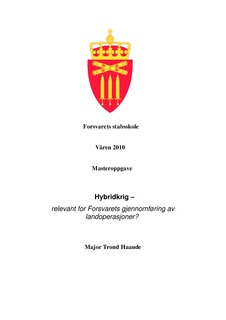| dc.description.abstract | The focus of this thesis addresses the emerging phenomenon known as Hybrid Warfare and its relevance to the Norwegian Armed Forces execution of land operations. This thesis is divided into two components. The first component explores the recent phenomenon of Hybrid Warfare, and the second part analyzes whether elements of Hybrid Warfare have any relevance for the Norwegian Armed Forces execution of land operations. The thesis limits land operations to those conducted by Norwegian Armed Forces on Norwegian territory, primarily against conventional adversaries. Hybrid Warfare, as a theoretical framework and a description of how some state and nonstate actors conduct war, has become more reputable in the last four to five years. Military theory traditionally recognizes a dichotomy between guerrilla warfare and conventional warfare. The theory of Hybrid Warfare is a fusion of both of these theories. In order to expand the theoretical comprehension of Hybrid Warfare, I have studied the 2006 Lebanon War. The casestudy focuses primarily on how Hezbollah conducted operations—to include their strategy, tactics, techniques and procedures. Based on an analysis of Norwegian strategic culture, I argue that some elements of the Hybrid Warfare framework have relevance in a Norwegian context. This is foremost the ability to absorb an enemy attack, and secondly the ability to strategically strike the enemy. To achieve this, the Land Forces primarily have to be able to sustain their fighting power and thereby delay an enemy advance, including inflicting maximum enemy losses. Land Forces composed of a mix of light and heavy maneuver-units, able to utilize complex terrain, speed and joint fires can achieve this. The Norwegian Land Forces ability to strategically strike the enemy is primarily of an indirect character, by protecting and supporting other joint capabilities such as Air Force assets and eventually, NATO-reinforcements. | en_US |
